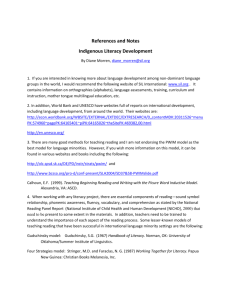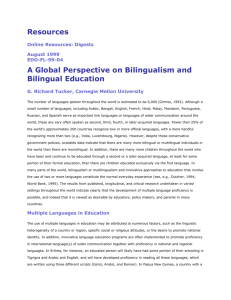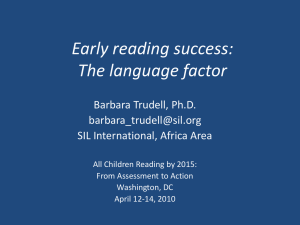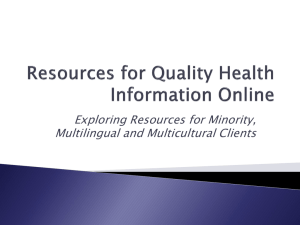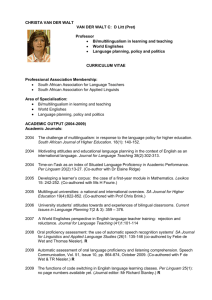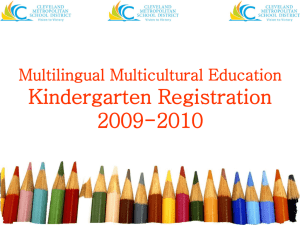ď - Sites
advertisement
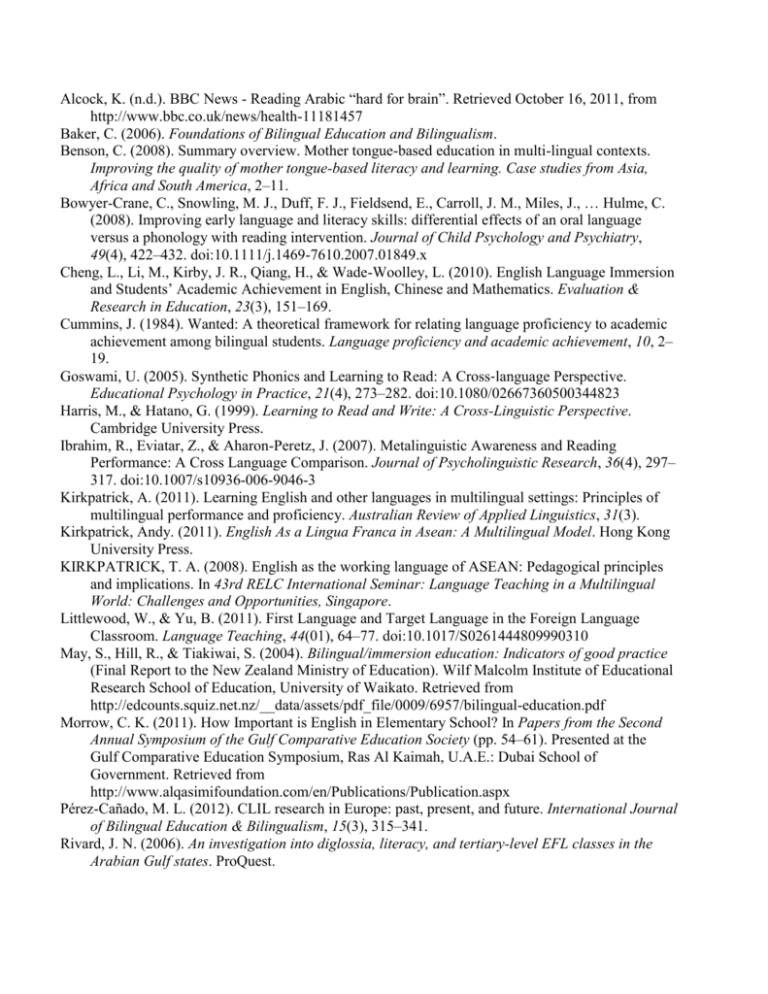
Alcock, K. (n.d.). BBC News - Reading Arabic “hard for brain”. Retrieved October 16, 2011, from http://www.bbc.co.uk/news/health-11181457 Baker, C. (2006). Foundations of Bilingual Education and Bilingualism. Benson, C. (2008). Summary overview. Mother tongue-based education in multi-lingual contexts. Improving the quality of mother tongue-based literacy and learning. Case studies from Asia, Africa and South America, 2–11. Bowyer-Crane, C., Snowling, M. J., Duff, F. J., Fieldsend, E., Carroll, J. M., Miles, J., … Hulme, C. (2008). Improving early language and literacy skills: differential effects of an oral language versus a phonology with reading intervention. Journal of Child Psychology and Psychiatry, 49(4), 422–432. doi:10.1111/j.1469-7610.2007.01849.x Cheng, L., Li, M., Kirby, J. R., Qiang, H., & Wade-Woolley, L. (2010). English Language Immersion and Students’ Academic Achievement in English, Chinese and Mathematics. Evaluation & Research in Education, 23(3), 151–169. Cummins, J. (1984). Wanted: A theoretical framework for relating language proficiency to academic achievement among bilingual students. Language proficiency and academic achievement, 10, 2– 19. Goswami, U. (2005). Synthetic Phonics and Learning to Read: A Cross‐language Perspective. Educational Psychology in Practice, 21(4), 273–282. doi:10.1080/02667360500344823 Harris, M., & Hatano, G. (1999). Learning to Read and Write: A Cross-Linguistic Perspective. Cambridge University Press. Ibrahim, R., Eviatar, Z., & Aharon-Peretz, J. (2007). Metalinguistic Awareness and Reading Performance: A Cross Language Comparison. Journal of Psycholinguistic Research, 36(4), 297– 317. doi:10.1007/s10936-006-9046-3 Kirkpatrick, A. (2011). Learning English and other languages in multilingual settings: Principles of multilingual performance and proficiency. Australian Review of Applied Linguistics, 31(3). Kirkpatrick, Andy. (2011). English As a Lingua Franca in Asean: A Multilingual Model. Hong Kong University Press. KIRKPATRICK, T. A. (2008). English as the working language of ASEAN: Pedagogical principles and implications. In 43rd RELC International Seminar: Language Teaching in a Multilingual World: Challenges and Opportunities, Singapore. Littlewood, W., & Yu, B. (2011). First Language and Target Language in the Foreign Language Classroom. Language Teaching, 44(01), 64–77. doi:10.1017/S0261444809990310 May, S., Hill, R., & Tiakiwai, S. (2004). Bilingual/immersion education: Indicators of good practice (Final Report to the New Zealand Ministry of Education). Wilf Malcolm Institute of Educational Research School of Education, University of Waikato. Retrieved from http://edcounts.squiz.net.nz/__data/assets/pdf_file/0009/6957/bilingual-education.pdf Morrow, C. K. (2011). How Important is English in Elementary School? In Papers from the Second Annual Symposium of the Gulf Comparative Education Society (pp. 54–61). Presented at the Gulf Comparative Education Symposium, Ras Al Kaimah, U.A.E.: Dubai School of Government. Retrieved from http://www.alqasimifoundation.com/en/Publications/Publication.aspx Pérez-Cañado, M. L. (2012). CLIL research in Europe: past, present, and future. International Journal of Bilingual Education & Bilingualism, 15(3), 315–341. Rivard, J. N. (2006). An investigation into diglossia, literacy, and tertiary-level EFL classes in the Arabian Gulf states. ProQuest. Short, D., & Fitzsimmons, S. (2007). Double the work: Challenges and solutions to acquiring language and academic literacy for adolescent English language learners: A report to Carnegie Corporation of New York. Alliance for Excellent Education. Ziegler, J. C., & Goswami, U. (2006). Becoming literate in different languages: similar problems, different solutions. Developmental Science, 9(5), 429–436.
